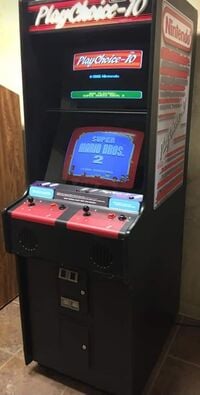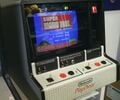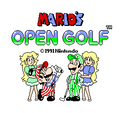Nintendo PlayChoice-10
| Nintendo PlayChoice-10 | |
|---|---|
 Super Mario Bros. 2 in a dual-screen cabinet | |
| Release date | August 1986[1][2] |
| Discontinued | Mid 1992 |
| Predecessor | VS. System |
| Successor | Nintendo Super System |
The Nintendo PlayChoice-10 is an arcade machine that consists of ten different games that had previously been available only on the Nintendo Entertainment System (NES). It was one of the last arcade machines made by Nintendo before the company announced it would stop making coin-op equipment in 1992.[3][4] The PlayChoice-10 was never released in Japan.
Description and history
Because the home gaming consoles were nearing the popularity of arcade machines, video game companies (e.g., Sega and Nintendo) decided to capitalize on this trend by making standup arcade machines out of their existing console systems. Nintendo, being the industry leader at the time, was especially successful with this concept. Nintendo packed its most popular games (e.g., Duck Hunt and Excitebike) into a machine case and called it the PlayChoice-10. This system served to advertise new NES games, some of which debuted before their Western NES release like Super Mario Bros. 3. Like with its successor for the Super Nintendo Entertainment System, the Nintendo Super System, players insert coins to play for an allotted time. While seven titles of the Super Mario franchise were released for the PlayChoice-10, the Super System received just one, Super Mario World.
The machine was compatible with the NES, but it was actually quite different. Normal NES cartridges could not be used; rather, the PlayChoice used special expansion cards containing usually unmodified NES games along with extra 8KB ROM to display hints for dual-screen machines. Due to the fact that the PlayChoice-10 output RGB video using a slightly different palette, games did not look exactly the same as they did on the NES. Usually, the PlayChoice versions are much more faithful to the NES version when compared to the VS. System versions, which are usually adjusted to become more difficult. Mario's Open Golf is a rare example of a PlayChoice version that has been altered considerably, in this case slimmed down to a few modes.
The earliest PlayChoice-10 cabinets were dual-screen ones based on the Punch-Out!!-type. There are conversion kits to turn Punch Out!!, Super Punch-Out!!, and Arm Wrestling machines. In Europe, there are also dual-screen setups with the top screen being much smaller than the bottom.[5] These types were produced by several licensed European manufacturers, which led to different form factors. They coexisted with the Punch-Out!!-type imported from the United States. In all versions, the bottom screen is where the game is displayed, with the top screen showing the menu, tips, instructions, and remaining playing time.
Starting in 1988, Nintendo began selling both dedicated single-screen upright cabinets and conversion kits for older Nintendo cabinets (Donkey Kong, Donkey Kong Jr., Popeye, and VS. UniSystem). The dedicated single-screen cabinet is displayed simply as "PlayChoice" and uses the same type of cabinet as the VS. UniSystem but is painted black instead of gray. There is also the rarer and more portable PlayChoice CounterTop that appeared in 1989.[6] Finally, conversion kits for the VS. DualSystem were made available also in 1989.[7] Although these systems have two screens, only one is visible from the player's perspective.
Machine operators had the option to purchase a PlayChoice-5 conversion kit when upgrading their machines. These allowed only five games to be played in the machine.
List of Super Mario games
- Dr. Mario (1990)
- Golf (1986)
- Mario Bros. (1986)
- Mario's Open Golf (1992)
- Super Mario Bros. (1986)
- Super Mario Bros. 2 (1988)
- Super Mario Bros. 3 (1989)
Gallery
Mario's Open Golf title screen



